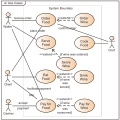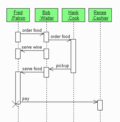- Object diagram
-
UML diagrams Structural UML diagrams Class diagram Component diagram Composite structure diagram Deployment diagram Object diagram Package diagram Profile diagram Behavioural UML diagrams Activity diagram Communication diagram Interaction overview diagram Sequence diagram State diagram Timing diagram Use case diagram An object diagram in the Unified Modeling Language (UML), is a diagram that shows a complete or partial view of the structure of a modeled system at a specific time.
An Object diagram focuses on some particular set of object instances and attributes, and the links between the instances. A correlated set of object diagrams provides insight into how an arbitrary view of a system is expected to evolve over time. Object diagrams are more concrete than class diagrams, and are often used to provide examples, or act as test cases for the class diagrams. Only those aspects of a model that are of current interest need be shown on an object diagram.
Contents
Object diagram topics
Instance specifications
Each object and link on an object diagram is represented by an InstanceSpecification. This can show an object's classifier (e.g. an abstract or concrete class) and instance name, as well as attributes and other structural features using slots. Each slot corresponds to a single attribute or feature, and may include a value for that entity.
The name on an instance specification optionally shows an instance name, a ':' separator, and optionally one or more classifier names separated by commas. The contents of slots, if any, are included below the names, in a separate attribute compartment. A link is shown as a solid line, and represents an instance of an association.
Object diagram example
As an example, consider one possible way of modeling production of the Fibonacci sequence.
In the first UML object diagram on the right, the instance in the leftmost instance specification is named v1, has IndependentVariable as its classifier, plays the NMinus2 role within the FibonacciSystem, and has a slot for the val attribute with a value of 0. The second object is named v2, is of class IndependentVariable, plays the NMinus1 role, and has val = 1. The DependentVariable object is named v3, and plays the N role. The topmost instance, an anonymous instance specification, has FibonacciFunction as its classifier, and may have an instance name, a role, and slots, but these are not shown here. The diagram also includes three named links, shown as lines. Links are instances of an association.
In the second diagram, at a slightly later point in time, the IndependentVariable and DependentVariable objects are the same, but the slots for the val attribute have different values. The role names are not shown here.
In the last object diagram, a still later snapshot, the same three objects are involved. Their slots have different values. The instance and role names are not shown here.
Usage
If you are using a UML modeling tool, you will typically draw object diagrams using some other diagram type, such as on a class diagram. An object instance may be called an instance specification or just an instance. A link between instances is generally referred to as a link. Other UML entities, such as an aggregation or composition symbol (a diamond) may also appear on an object diagram.
References
External links
- General information on UML including the official UML 2.0 specification. See especially the section on InstanceSpecification.
- The Expressive Power of Object Diagrams, an illustration from the real world
Unified Modeling Language Actors Organizations: Object Management Group • UML Partners Persons: Grady Booch • Ivar Jacobson • James Rumbaugh


Concepts Object oriented: Object-oriented programming • Object-oriented analysis and design
Structure: Actor • Attribute • Artifact • Class • Component • Interface • Object • Package • Profile diagram
Behavior: Activity • Event • Message • Method • State • Use case
Relationships: Aggregation • Association • Composition • Dependency • Generalization (or Inheritance)
Extensibility: Profile • Stereotype
Other concepts: MultiplicityDiagrams StructuralClass diagram • Component diagram • Composite structure diagram • Deployment diagram • Object diagram • Package diagramBehaviourActivity diagram • State Machine diagram • Use case diagramInteractionDerived languages Systems Modeling Language (SysML) • UML eXchange Format (UXF) • XML Metadata Interchange (XMI)Other topics Categories:- UML diagrams
- Unified Modeling Language stubs
Wikimedia Foundation. 2010.


